This week I spent two days in sunny, beautiful San Diego, California. I had been sponsored to attend the Network for Social Work Management’s annual conference. where every year they bring together a large audience of social workers, human service organization representatives, international experts, researchers, and practitioners to learn about innovative social work management practices. With plenary sessions, workshops, and networking opportunities, my time was PACKED with activities!
As I sit here just three days post the conference, I am thinking back at all of the things that I learned and absorbed in such a short amount of time. On day one, hundreds of people filled the beautiful conference room inside San Diego State University’s Montezuma Hall. We were quickly enlightened about the theme of the this year’s conference – Disruptive Leadership. Here, we often heard the term disrupting norms. Many speakers shared that in order for change to happen it was imperative for social workers to interrupt the status quo.
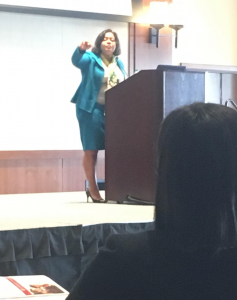
Antonia Jimenez, B.S., Keynote Speaker on the benefits and challenges of implementing change.
Antonia Jimenez, Director LA Department of Social Services, explained in her speech that we as social workers must be a hybrid of both vision and implementation. She continued to state that we must speak up about our ideas even when we think people don’t hear us. I really liked her story of when she was working for a governor who once told her that two of his goals, when he was to retire, was (1) to be known for the innovations he had created and (2) plant the innovative seeds for the next governor. Altogether, her humor and vulnerability to describe her journey was a great way to break the ice and start off the morning.
With one of my colleagues, Heather Mercer, I went to attend a workshop about how to be inclusive when working with college students. The trainers spoke about the different tools that they have seen to be successful as they attempted in their research to test the climates of their classrooms. For example, Dawn Shedrick spoke about incorporating community agreements at the beginning of the semester. This is a list of agreements that are mutually agreed upon and to be carried out throughout the course. These can include items such as one diva one mic, ELMO (enough let’s move on), and respecting others’ opinions. This helps in setting connection before bringing up sensitive topics. Dawn also spoke about incorporating activities to encourage engagement. One exercise she uses is asking all students to say something that they respect about their classmates. When students feel respected by their peers, this encourages them to be vulnerable. Lastly, to empower students, she often replies to them by saying, “you’re not the only one at this school that’s noticed/experienced that.” Feeling like they are not alone, students will feel better about their experience seeing that others have also had similar experiences. My biggest takeaway in this conference was noting how easy and fun these tools can be in a classroom. With such little effort, these tools can really be conducive to safe and friendly environments for students and the teacher.
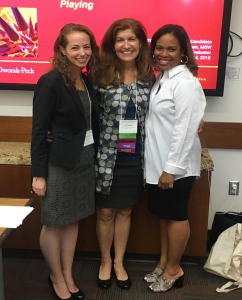
USC’s Laura Witcoff, MSW, LICSW, Lauren E. Brown, MPP, Ph.D., and Jennifer Goldstein at their presentation on Gamifying Engagement.
In another workshop, I learned how utilizing games to attract an audience can be effective. One of my professors at USC, Dr. Lauren Brown, spoke with her research team about their concepts of media that work for nonprofits. Their research looked at ways that technology can benefit a nonprofit organization and its promotion. The workshop audience was split up into groups of two where each group was assigned a scenario of an agency and their mission. Our jobs were to create game ideas that were in line with the message we wanted to relay. My group was given a mock agency of an interim housing for homeless families in Los Angeles. The agency’s mission was to eliminate homelessness among families with children in Los Angeles by providing housing, supportive services, and advocacy. The message was, “All children and families deserve a home.” Together, my group brainstormed ideas about what could captivate people to learn/donate/advocate for this specific agency. We went straight to the drawing board and came up with some creative game ideas, such as: asking people to write about their favorite family moment, talk about what it means to have a home, and share what their favorite childhood toy was. In this manner, people will reflect on their childhood, family, home, and privileges, encouraging them to participate with the agency. Although social media and tech games are not my particular forte, I can see the power in these creative skills to capture audiences. A simple game that brings light to privilege and experience can make the participation empathetic and personal.
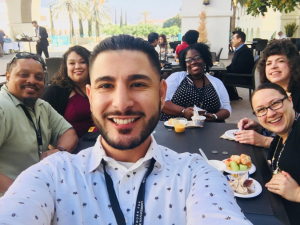
A morning breakfast with SISGI staff and interns (from left to right: Robert, Patty, Gabe [center], Thenera, Andrea, and Heather).
Once day-one came to an end, my internship team met together at a local restaurant. I thought to myself that after being focused all day I wasn’t sure I can come up with the energy to socialize but of course I did. There were six of us at the table, and we had a blast! Our conversations were un-serious, and although many of us have vast differences, there was just something in every person at that table that I truly liked. Each person brought a unique set of characteristics, talents, and wisdom that wholly made us work so well.
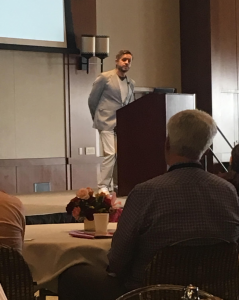
Christopher “Chip” Paucek presenting a keynote on Leadership Lessons: A CEO’s Perspective on Leading through Change, Building a Great Culture and Cultivating Talent.
Finally, after a long day-one, we were back at it the next day for day two! The day was set to end a bit earlier and incorporate more workshops and plenaries. Day two was kicked off with a presentation by CEO of the world’s best digital education – 2U, Chip Paucek. He was an approachable man with a strong history of pushing through the cracks. Chip spoke about his original idea of technology being unattractive, threatening, and invasive to academics. While practitioners also saw social media as a burden. It took him years until he slowly started to “normalize” this notion of digital education as a new platform for colleges. He struggled to create acceptance of his product, but he endured and found himself finally breaking way. Colleges that finally gave his company a shot began to see the benefits of having such a platform incorporated into their schools. Chip’s closing remarks spoke about appreciation and staying optimistic and grateful. Hearing Chip’s story gave me a sense of hope. Hope that although I may not succeed with my first ideas and there may be obstacles, staying optimistic and persevering through these trials is what gets you to the end of the tunnel.
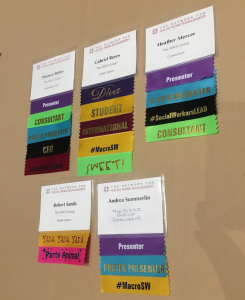
SISGI Group attendees’ name badges with some added bling.
In the late morning, I took a workshop on research that showed how to get legislative attention to the causes we’re advocating for as social workers. The instructor spoke about his research from his five-step process to push forward in an evidence-based manner to move from the idea to get it voted on. With over a dozen organizations that Minarik used in his study to show how his model is effective, he proposes that having a tailored information sharing decision model is promising. Legislature for me always seems so grand and intangible, but I really liked how his steps gave realistic steps for social workers who are interested in this process.
As day two came to an end, I reflected on my time at the conference, which altogether was well effective and purposeful. This opportunity gave me the ability to meet many people in this field: researchers, professors, social workers, students, interns, business-owners, etc. I learned so much about what we can do to be a disruptive leader. I was inspired by the stories shared by our plenary speakers. I was renewed by the energy of my internship colleagues. And I found faith in my future as a social worker as I learned about what many ways social work is making an impact.
Upcoming Virtual Conference Opportunity!
If you didn’t get a chance to attend this year’s Network for Social Work Management Conference, there’s still a great opportunity coming around the corner, and the best part about it is that it will be a virtual conference. You don’t even have to travel anywhere! On August 6th – 8th 2018, my internship site, SISGI Group, will hold our annual Alliance for Positive Youth Development Conference #APYDCON. Here, attendees will leverage technology and social media to share and connect with youth development professionals, educators, and young people working on youth issues. Specifically, we will have lecturers and panelists each day that will discuss best practices that can be used for Trauma-Sensitive Education, Youth Homelessness, and LGBT+ Bullying in School Settings.
For more information and to register for the Alliance for Positive Youth Development Conference visit ideas4youth.org/apydcon. If you would like to become an exhibitor then click here to fill out the virtual exhibit hall application.
If you’d like more information about the Network for Social Work Management, please visit their site at https://socialworkmanager.org/


